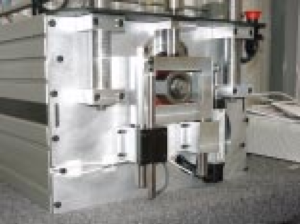Velocity Transducer in Shock Absorber Testing Machine
A leading maker of damper dynamometers has several lines of suspension testing machines that are used by automotive companies and OEM manufacturers to quickly and accurately characterize the performance of dampers (better known as shock absorbers in the US). With 500 systems installed worldwide, prominent customers include Ford, GM, Delphi Chassis, Lord Corp., and Harley Davidson. Numerous racing teams from NASCAR’s Winston Cup, Busch and Craftsman Truck Series are also common users.

Data representing force, displacement, temperature and velocity is collected from several installed sensors on each machine. This information is fed into instrumentation software to generate graphs that reveal damper performance. The most popular curves used by customers are force vs. velocity (hysteresis), force vs. absolute velocity and force vs. displacement. The velocity component is obtained through our Series 100 LVT.
Selected by working range, the Models 0113, 0114, 0122 & 0123 are used to measure linear shaft speed of each tested damper. A “scotch yoke” setup is used to translate angular motion from the rotary drive motor into linear motion. With each compression/rebound cycle, the damper shaft is stroked through a preset displacement range. The LVT (attached to the left side of the yoke as seen in the photo) follows this movement and outputs a VDC signal that relates to speed. In simple linear modeling, the velocity readings are critical because the damping forces that are produced are directly proportional to the damper shaft speed.

This manufacturer’s standard dynamometers run at test speeds of 38-90 inches/second. A newer generation machine – the EMA – is capable of speeds over 4 meters/ second. With help from our LVTs, these systems go a long way in improving ride quality in a passenger vehicle or helping a crew chief win a race.